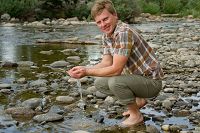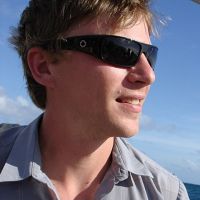Critical Zone Q&A with researcher Adrian Harpold
19 Oct 2016
University of Nevada Reno's Adrian Harpold reflects on his past and present time researching at Critical Zone Observatories.
Adrian Harpold, assistant professor at the University of Nevada Reno and longtime researcher at several Critical Zone Observatories, visited the Univesrity of California Merced on September 14, 2016. He presented a lecture at an Environmental Systems Seminar covering how mountain snowpack and water resources are being impacted by rising temperatures and forest disturbance, in addition to talking science with Southern Sierra research faculty and students. Adrian answered a few questions for us about his time working with Critical Zone Observatories, from initial instrument installations in the Jemez River Basin to cross-CZO LiDAR research at four different sites.
Q: How did you start working with Critical Zone Observatories?
AH: As a post-doc at University of Arizona, I worked at both the Santa Catalina and Jemez River Basin CZOs. In particular, I was part of the team that installed much of the initial instrumentation at the sites in the Jemez and then spent three months living in the area to run the Spring sampling campaign. One week after moving away, the Las Conchas fire burned a large part of the area.
Q: What topics have you researched at different CZOs? What sorts of projects have you worked on?
AH: My work has mainly been focused on the effects of snowpacks on hydrologic and biogeochemical transport. Most of my work has been at the Jemez River Basin, but I have also conducted field work at Boulder Creek CZO, and synthesized data from across the CZO network. After working at the University of Arizona, I then moved to Boulder for a post-doc at the University of Colorado funded by NSF that involved cross-CZO work comparing snow-vegetation processes across the Jemez, Southern Sierra, and Boulder Creek CZOs. Working with Chris Tennant, now a post-doc at UC Berkeley, and with funding by a CZO SAVI grant, we have been comparing snow LiDAR flight from four CZO sites, including Reynolds Creek.
Q: As you reflect on your past and present time working with the CZO network, how has working with individual CZOs and across the CZO network helped you develop as a researcher?
AH: There is no question that CZOs have aided my development as a scientist and a researcher. While I could point to specific scientific questions they have helped me develop, I think the real benefits have been learning how to be an interdisciplinary scientist and taking advantage of opportunities to interact with new people. I will forever remember sitting in a big room at the University of Arizona with some of the most respected hydrologists, soil scientists, geomorphologists, biogeochemists, and ecologists in the country and having lively conversations about science topics. That sense of scientific excitement and an openness to challenging and learning from others is often hard to find - especially working by yourself in your office! I also strongly benefited from CZO opportunities to travel and meet new people. For example, last year I was able to travel with a CZO contingent to China and discuss how to apply Critical Zone research techniques to their field sites. The trip was amazing in terms of the science opportunities I saw there, as well as a realization that critical zone science transcends cultural and national boundaries.
News article by Michelle Gilmore
News Category:
RESEARCH |
INFRASTRUCTURE |
PEOPLE |
AWARD |
EDUCATION/OUTREACH
Publications
2016 (In Press)
Diverging Sensitivity of Soil Water Stress To Changing Snowmelt Timing in the Western US . Harpold, A.A. (2016): Advances in Water Resources. 10.1016/j.advwatres.2016.03.017
2015
Sensitivity of Soil Water Availability to Changing Snowmelt Timing in the Western US . Harpold, A.A., and Molotch N.P. (2015): Geophysical Research Letters. 42.
2015
Soil moisture response to snowmelt timing in mixed-conifer subalpine forests. Harpold A. A., Molotch N. P., Musselman K. N., Bales R. C., Kirchner P. B., Litvak M. and Brooks P. D. (2015): Hydrological Processes 29(12): 2782–2798
Discipline Tags and CZOs
Climatology / Meteorology
Hydrology
GIS / Remote Sensing
Modeling / Computational Science
National
Boulder
Catalina-Jemez
Reynolds
Sierra
Explore Further




